|
The
Origin of a Myth:
Mary Shelley's Novel Frankenstein
Download
the complete text here
(ZIP archive 161KB)
or
click here for a
short summary of the novel
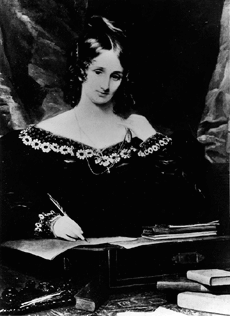
Portrait of Mary Shelley
|
The life of a monster creator:
Mary Shelley's
biography
Even before she was born,
Mary Shelley (1797-1851) was destined to become one of the most prominent figures
in English literature. Both her parents
were revolutionaries and writers: Her father William Godwin (1756-1836) was an
English journalist and novelist and one of the major proponents of
anarchist philosophy. His most famous works were An Enquiry
Concerning Political Justice, an attack on political
institutions, and The Adventures of Caleb Williams, which
attacks aristocratic privilege.
Mary's mother Mary Wollstonecraft (1759-1797), one of the earliest
feminists, was equally radical. In her book A Vindication of the
Rights of Women Wollstonecaft argues that the inferior role of
women in society was not natural, but rather a consequence of
miseducation. She called for equality of women and men, the women's
right to work and proper education for girls. Although she died ten
days after giving birth to her daughter Mary, her works continued to
influence Mary Shelley.
|
Mary grew up surrounded by intellectual minds and she was educated and
tutored by her father, who married his second wife Mary Jane Clairmont
in 1801.
In 1812 Mary Wollstonecroft Godwin met Percy Bysshe Shelley (1792-1822),
who visited her father at his bookshop. Percy Shelley, a poet and
radical free-thinker, fell in love with Mary, despite being still
married to his first wife Harriet. Mary and Percy both shared a love for
literature and they used to discuss literary classics and philosophy. In
the summer of 1814 they eloped to France, together with Mary's step
sister Jane Clairmont. Mary's father, who had always proclaimed free
love, did not approve of this relationship and did not talk to his
daughter for more than a year.
In 1816 Mary and Percy travelled to Switzerland, where Mary conceived Frankenstein. They got married on December 30, after Percy's first wife
Harriet had comitted suicide.
This was followed by a period of constant moving, first in England,
later in Italy, which was overshadowed by the death of Mary's children
Clara and Will. On 8 July 1822 - the Shelleys had moved to Pisa earlier
- Percy
Shelley died in a sailing accident. Mary was left with her only
surviving child Percy Florence Shelley and spent the rest of her life in
England promoting her late husband's work. She also continued her own
literary career. In 1826 she published The Last Man, a science
fiction novel about a post-apocaclyptic world ravaged by a terrible
plague, which became her second-best known book.
Mary Shelley continued to be surrounded by prominent figures of
literature and art, but at the same time was met with hostility and
disapproval from more conventional circles. She died on 1 February 1851.
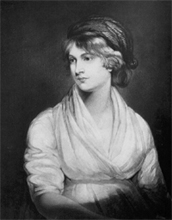
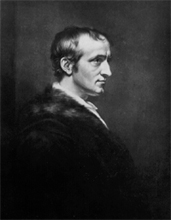
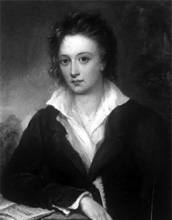
Mary Wollstonecraft
William Godwin
Percy Bysshe Shelley
Creating a legend: The
summer of 1816
The
origin of Frankenstein
is
almost as mysterious and exciting as the novel itself. It all began
back in the summer of 1816 at the famed Villa Diodati on the shores
of Lake Geneva, Switzerland, where Mary Shelley spent
most of that summer together with her future husband Percy Bysshe
Shelley, her stepsister Claire Clairmont, Lord Byron and Dr. John
Polidori, Byron's physician. Inspired by a reading of the Fantasmagoriana, a collection of German ghost stories, on June 16
they decided to try their hands on supernatural stories themselves.
The first one to come up with a story was Polidori, who began
his now famous tale The Vampyre. Its main protagonist Lord Ruthven was
supposedly modeled on Lord Byron. However, Mary Shelley was not that
quick in creating her first piece of literature. Initially, she suffered
from some kind of writer's block and produced nothing so far until one day she
had (or claimed to have) a sort of vision that finally inspired her to write
Frankenstein.
She described this vision in the preface of the novel:
"I
placed my head on my pillow, I did not sleep, nor could I be said to
think. My imagination unbidden, possessed and guided me.. I saw with shut
eyes, but acute mental vision, - the pale student of unhallowed arts
standing before the thing he had put together, I saw the hideous phantasm
of a man stretched out, and then, on the working of some powerful engine,
show signs of life and stir with an uneasy, half vital motion... frightful
must it be; for supremely frightful would be the effect of any human
endeavour to mock the stupendous mechanism of the Creator of the world.
His success would terrify the artist; he would rush away from his odious
handiwork, horror stricken.... He (the artist) sleeps but he is awakened;
he opens his eyes; behold, the horrid thing stands at his bedside, opening
his curtains and looking on him with yellow, watery, but speculative
eyes."
A
couple of days later, Mary Shelley finally began to write her own ghost
story that would then become chapter IV of Frankenstein. She completed
the novel in 1817 and the first edition was
published anonymously in 1818, with a preface by Percy Shelley. (A brief summary is available here.)
Only 500 copies were printed and the novel
was split in three parts. Although historical novelist Walter Scott,
author of Ivanhoe, liked Frankenstein and wrote "the
work impresses us with a high idea of the author's original genius and
happy power of expression", most reviews at the time were rather unfavourable.
The Quarterly Review wrote the following in 1818:
"Our taste and our judgement
alike revolt at this kind of writing, and the greater the ability with
which it may be executed the worse it is -- it inculcates no lesson of
conduct, manners, or morality; it cannot mend, and will not even amuse
its readers, unless their taste have been deplorably vitiated"
Still,
the novel had already become quite popular and had even
spawned several theatrical adaptations, the best known of them
Brinsley Peake's Presumption.
A second edition (this time credited to Mary Shelley) was published in
1823 in two volumes.
In October 1831 a revised edition of Frankenstein was published in one
volume. Mary Shelley had made several changes to this version: She added
a longer preface, Victor Frankenstein was portrayed as a more benevolent
character and indications of an incestuous relationship between Victor
and Elizabeth were removed by clearly marking her as the adopted child
of the Frankensteins.
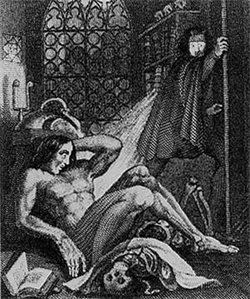
Frontispiece illustration to 1831 edition of Frankenstein
When Mary Shelley composed Frankenstein, she was influenced by several
literary classics she had read with her future husband Percy. She
references these works in Frankenstein, among them Ovid's Metamorphoses
and John Milton's Paradise Lost.
At one point in the novel, the monster says,
after reading Paradise Lost, he sympathizes with Satan's role in the
story:
"But Paradise Lost excited different
and far deeper emotions.
[...] Like Adam, I was apparently united by no link to any other being
in existence; but his state was far different from mine in every
other respect. He had come forth from the hands of God a perfect
creature, happy and prosperous, guarded by the especial care
of his Creator; he was allowed to converse with, and acquire
knowledge from, beings of a superior nature: but I was wretched,
helpless, and alone. Many times I considered Satan as the fitter
emblem of my condition; for often, like him, when I viewed
the bliss of my protectors, the bitter gall of envy rose within me."
The name Frankenstein was probably taken from a castle near the German
town of Darmstadt, where Mary and Percy had travelled through on their
way from Basel. According to a highly disputed theory by German
historian Walter Scheele, Mary had heard of Johann Konrad Dippel, a
German alchemist, who had lived at Burg Frankenstein in the early 18th
century. Legend has it that Dippel experimented with dead bodies and was
able to create an artificial monster, just like Victor Frankenstein.
Additionally, alchemy and galvanism were popular topics at the time and
Mary knew about them.
One particularly interesting influence is the Swiss painter Henry Fuseli,
who once had a relationship with Mary's mother, that lasted four years.
Fuseli's painting The Nightmare
inspired the description of Elizabeth's dead body flung across her
bridal bed just after her murder by the creature in chapter 23:
"She was there, lifeless and inanimate,
thrown across the
bed, her head hanging down, and her pale and distorted features
half covered by her hair. Everywhere I turn I see the same
figure--her bloodless arms and relaxed form flung by the
murderer on its bridal bier."
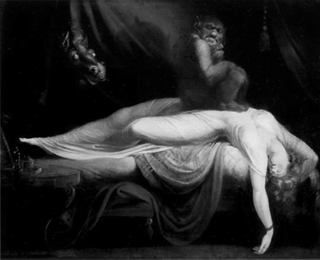
The Nightmare by Henry Fuseli (1781-82)
What to do with a monster: Interpreting
Frankenstein
But what
exactly was it that Shelley wanted to express with Frankenstein
? Does she condemn the protagonist Victor Frankenstein for his hubris or
does she approve of his deeds? Due to the fact that throughout the novel Frankenstein,
Mary Shelley never explicitly comments on her position, Frankenstein is an
open invitation for all sorts of theories and interpretations. The following
section is dedicated to these questions and presents a number of possible
different interpretations of Frankenstein based on the work of
several critics.
These different readings of Frankenstein, on the one hand
conservative criticism on science, on the other hand the Promethean
believe in the unlimited progress of science, are based on the three
different narrators of the novel. Two contradicting points of view are
expressed in the narratives of Frankenstein and the Monster, whereas
Walton's frame narrative basically supports Victor Frankenstein's point of
view. Therefore the value of Mary Shelley's novel lies not in presenting a
clear morale but in encouraging the readers to make up their own.
Victor
Frankenstein's original reasons for creating life from dead parts are
noble. His driving force is the desire to help mankind conquer death and
diseases. But when he finally reaches the goal of his efforts and sees his
creature and its ugliness, he turns away from it and flees the monstrosity
he has created. From that moment on he tries to suppress the consequences
of his experiments and wants to escape them by working in other sciences.
Victor even withdraws from his friends and psychological changes are
visible.
Mary Shelley seems not to condemn the act of creation but rather
Frankenstein's lack of willingness to accept the responsibility for his
deeds. His creation only becomes a monster at the moment his creator
deserts it (1). Thus Frankenstein warns of the
careless use of science - the book was written at an early stage of the
Industrial Revolution, a period of dramatic scientific and technological
advance. This is still an important issue, even 200 years
after the book was written. Taken into consideration what many inventions
of the last 50 years brought upon mankind, one must assume that many
scientists still do not care much. (E.g. the splitting of the atom was
turned into nuclear bombs and the invention of the computer resulted in an
eerie dehumanisation of our society). Most scientists seem to be like
Victor Frankenstein, who finished his work in the prospect of achieving
fame. Only when he realizes the repulsiveness of his creation, Victor
comes to senses. Intended as a warning, Victor tells his story to the
polar explorer Walton:
"I
will not lead you on, unguarded and ardent as I then was, to your
destruction and infallible misery. Learn
from me, if not by my precepts, at least by my example, how dangerous is
the acquirement of knowledge, and how much happier that man is who
believes his native town to be the world, than he who aspires to become
greater than his nature will allow." (Shelley: 51-52)(2)
In his corrupting pursuit for knowledge Victor Frankenstein is compared
to Prometheus, as the novel's subtitle "The Modern Prometheus"
suggests. In Greek and Roman mythology, the Titan Prometheus creates
mankind as an image of the Gods. Later he steals the precious fire form
Olympus and gives it to mankind. He is punished by Zeus, who has him
chained to Mount Cauasus, where day by day an eagle would eat out his
liver, which would then grow back. It is a typical example of "hubris", where a character
is doomed because he transgresses his limits and rises up against some
sort of authority, in Greek mythology usually a divine authority. The
mythological Prometheus rebelled against the Gods when he gave fire to
humankind; Frankenstein is a rebel against nature when he tries not only
to find the secret of life but also to remove life's defects (3).
But even more so, in Victor Frankenstein both aspects of the Prometheus
myth are embodied: the transgressive (hubris/rebellion against authority)
and the creative (Prometheus also molded mankind from pieces of clay).
Therefore Frankenstein is truly a drama of the romantic promethean
hero who fails in his attempt to help mankind.
Feminist literary theory claims that Frankenstein's act of creation
is not only a sin against God/nature. It is also an act against the "female
principle", which includes natural procreation as one of its central aspects. The Monster, the result of male arrogance, is the enemy and
destroyer of the eternal female principle (4). The
Monster is the child of an unnatural act of procreation in which woman has
become unnecessary. The male, who is the executive power in a patriarchal
system, has deprived woman of her most natural function because he is now
able to
create children without female participation. The present discussion about
genetic engineering and human cloning shows that this is not a far-fetched
utopia.
At
least in his subconscious Frankenstein must have realised his crime
against the "female principle", which becomes clear in the
following symbolic dream. In the night after the reanimation of the
Monster Victor has a nightmare in which he kills his mother and his fiancée: |
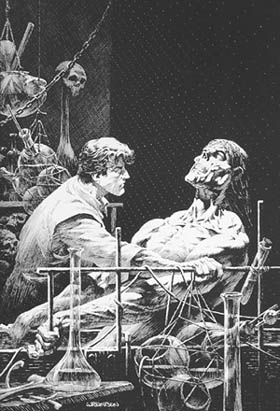
Frankenstein creates the
fiend - illustration by
Bernie Wrightson (© 1977) |
"I
thought I saw Elizabeth, in the bloom of health, walking in the streets of
Ingolstadt. Delighted and
surprised, I embraced her; but as I imprinted the first kiss on her lips,
they became livid with the hue of death; her features appeared to change,
and I thought that I held the corpse of my dead mother in my arms; a
shroud enveloped her form, and I saw the grave-worms crawling in the folds
of the flannel. " (Shelley: 57) (2)
At
the same time Frankenstein is not willing to fully take the role of the
mother of his "child". Immediately after its birth he leaves his
child and thereby evades his parental duty to care for the child.
Walton,
constructed as a parallel to Frankenstein, is kept from continuing his
dangerous journey by Frankenstein's cautionary tale. But in contrast to Walton
Frankenstein's character remains somehow ambivalent. Although he feels
remorse for his deeds he ends his tale with a rather strange statement:
"Farewell,
Walton! Seek happiness in
tranquillity and avoid ambition, even if it be only the apparently
innocent one of distinguishing yourself in science and discoveries. Yet why do I say this? I have myself been blasted in these
hopes, yet another may succeed." (Shelley: 210) (2)
Victor
Frankenstein has given up his attempts to create artificial life. But he still hopes that
someone else may successfully continue his works. This last sentence makes
all his warnings look like a farce. And it also brings up the assumption
that Mary Shelley really did not condemn the Promethean striving of her
hero. Probably she was not against scientific progress but only wanted to
warn of carelessness in science.
A
totally different position is represented in the Monster's narrative, the
central part of the novel. If only this narrative is considered, the
Monster appears to be an almost perfect creation (apart from his horrible
appearance), who appears often more human than the humans themselves. He is
benevolent (he saves a little child; he helps the De Lacey family
collecting firewood), intelligent and cultured (he learns to read and talk
in a very short time; he reads Goethe's Werther,
Milton's Paradise Lost and Plutarch's works). The only reason why he fails is his
repulsive appearance. After having been rejected and attacked again and
again by everyone he encounters only because of his horrible physiognomy,
the Monster, alone and left on his own, develops a deadly hatred against
his creator Frankenstein and against all of mankind. Therefore only
society is to blame for the dangerous threat to mankind that the Monster
has become. If people had
adopted the Monster into their society instead of being biased against
him and mistreating him he would have become a valuable member of the
human society due to his outstanding physical and intellectual powers.
Mary
Shelley's husband, the romantic poet Percy B. Shelley, saw Frankenstein as a summing up of one of the central ideas of the
enlightenment movement. The moral qualities and faults of a human being
are mainly the products of his/her private and social environment (5). Everything we become is simply a question of nature
vs. nurture. In his review "On Frankenstein" (1818)
Percy B. Shelley wrote:
"Nor
are the crimes and malevolence of the single Being, though indeed
withering and tremendous, the offspring of any unaccountable propensity to
evil, but flow irresistibly from certain causes fully adequate to their
production. They are the children, as it were, of Necessity and Human
nature. In this the direct morale of the book consists, and it is perhaps
the most important and of the most universal application of any morale
that can be enforced by example - Treat a person ill and he will become
wicked. Requite affection with scorn; let one being be selected for
whatever cause as the refuse of his kind - divide him, a social being,
from society, and you impose upon him the irresistible obligations -
malevolence and selfishness. It is thus that too often in society those
who are best qualified to be its benefactors and its ornaments are branded
by some accident with scorn, and changed by neglect and solitude of heart
into a scourge and a curse."
For Percy Shelley the problem does not seem to be Frankenstein's promethean
transgression because danger for mankind is not rooted in science but in
society itself. In this context Frankenstein's final words become quite
clear: Someone else should continue his experiments and remove the
creature's visible defects, in other words assemble a creature with a more
beautiful appearance, which would be accepted by society more easily. If
this could be achieved, the result would be the perfect artificial human
being.
At
this point other critics continue and read Frankenstein in a different context. To
them the book works as a harsh criticism on religion. (6) The horrible physiognomy of the Monster is
only a result of Frankestein's hurry and anxiety caused by his awareness
of committing a sin against God. Because of this unrest he uses inadequate
materials and assembles them too quickly. It implies that a scientist can
only work for the benefit of mankind if he breaks with the church and its
values. This reading of Frankenstein may have been influenced by Percy
Shelley's pamphlet "The Necessity of Atheism" (1810), where he
states that a reasoning human being has to deny the existence of God due
to a lack of proofs. However, one might easily share my opinion that this interpretation of Frankenstein
is a bit far-fetched. Since Victor Frankenstein is not at all a
professional surgeon he cannot be expected to create a perfect human being
out of partly rotten body parts, especially not with the kind of
instruments, assistance and funding he uses.
In
her preface to Frankenstein Mary
Shelley admits that her main goal was simply to write a ghost story. She got the
idea for what she later called her "hideous progeny" during the
legendary summer of 1816, which she spent at Lake Geneva in Switzerland
together with Percy Shelley, Lord Byron and Dr. John Polidori. Inspired by
Fantasmagoriana, a French translation of German Gothic tales, they
held some kind of ghost story competition where Mary Shelley invented her
story of Frankenstein.
But
the classification of Frankenstein
as a ghost story, Gothic novel or horror novel is not fully adequate,
considering the following facts: It
contains no supernatural apparitions such as ghosts, witches, devils, demons
or sorcerers. In Frankenstein
all "diabolical agency has been replaced by human, natural and
scientific powers" (7). Other typical Gothic elements,
e.g. ruined castles, graveyards and charnel houses, appear only briefly or
in the distance. And unlike most Gothic novels Frankenstein
is set in the 18th rather than in the 15th century.
Shelley also abandoned the simple good-evil scheme of the Gothic novel. Neither
Frankenstein nor the Monster are one hundred percent good or evil. Instead
they are both highly ambivalent characters. Frankenstein
is rather a kind of novel German literary critics call
"Entwicklungsroman", a form of the novel showing the development
of an individual's character. Both Victor and his creation change during
the novel as a consequence of their relationship. Furthermore, one could
argue that it shows the Monster's development from earliest childhood to
adulthood. And by making its protagonist hero as well as victim Frankenstein
is clearly set in the context of Romanticism. 
The
Frankenstein monster as a symbol for cloning: Cartoon on stem cell
research by Dick Wright (© 2001)
But
since one of its main topics is a scientific discovery, Frankenstein
could equally be called a precursor of the science fiction novel. The
artificially created Monster is often seen as a foreshadowing of recent
scientific developments like test-tube babies, robots and organ
transplantation. The Monster may also be interpreted as "a symbol of
the ambiguous nature of the machine" (8) or as a symbol
of modern technology.
© 2000 -2007
Andreas Rohrmoser
Footnotes:
1 cf. Weber, Ingeborg, "Doch einem mag es gelingen".
Mary Shelley's “Frankenstein“: Text, Kontext, Wirkung; Vorträge des
Frankenstein-Symposiums in Ingolstadt (Juni 1993). Ed. Günther
Blaicher (Essen: Verlag Die Blaue Eule, 1994) 24
2 Page numbers in quotations from Mary
Shelley's Frankenstein refer to the following edition:
Shelley, Mary: Frankenstein. (London: Penguin Books, 1992)
3 cf. Gassenmeier, Michael, "Erzählstruktur,
Wertambivalenz und Diskursvielfalt in Mary Shelleys Frankenstein".
Mary Shelley's “Frankenstein“: Text, Kontext, Wirkung; Vorträge des
Frankenstein-Symposiums in Ingolstadt (Juni 1993). Ed. Günther
Blaicher (Essen: Verlag Die Blaue Eule, 1994) 42
4 cf Markus, Manfred, "Mary Shelleys Frankenstein aus
biographischer Sicht".
Mary Shelley's “Frankenstein“: Text, Kontext, Wirkung; Vorträge des
Frankenstein-Symposiums in Ingolstadt (Juni 1993). Ed. Günther
Blaicher (Essen: Verlag Die Blaue Eule, 1994) 61
5 cf Gassenmeier 1994: 28
6 cf Gassenmeier 1994: 43
7 Botting, Fred, Gothic (London: Routledge, 1996) 103
8 Baldick,
Chris. In Frankenstein's Shadow: Myth, Monstrosity, and
Nineteenth-Century
Writing.
(Oxford: Oxford University Press, 1990) 7
|


